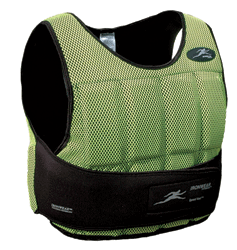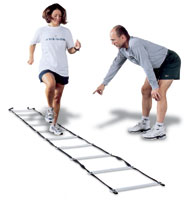Speed and Agility
While they are defined differently, they are closely related...
Speed and agility are qualities of fitness developed by athletes in many sports. While they are defined differently, they are closely related, and the right combination of sport-specific training exercises can boost all of them.


Speed is simply defined as the ability to move quickly.
A related component of physical fitness that has been listed by the President's Council is reaction time - how quickly you begin to move (e.g., the time from when you hear the starter's gun to the time you begin to move from the starting blocks).
Reaction time and movement time are determined by many factors. While genetics plays a role, training and experience can increase your quickness.
Examples: The 100 meter dash (determines the "world's fastest human"), the 40 yard dash, running to first base in softball, and olympic lifting. Fine rapid movements include playing a fast piece on a piano or keyboarding frantically to meet a deadline.
How to Develop Speed
Explosive activities and quick movements (e.g., reaction drills) in training.
Practice making responses that simulate specific sport movements (e.g., reacting to the movement of an opponent, planning responses in specific game situations, paying attention to the proper cues).
You will run faster by increasing both your stride length (how long) and stride frequency (how often). Speed vests are also used to increase, overload, an athlete's weight during training.
Improving coordination improves the rapid execution of movements due to greater mechanical efficiency (i.e., starting and sprinting technique). Include olympic lifting variations to develop rapid repositioning of the feet and reactive movements.
Further Explanation of Response Time
Let's say you are driving a car and you suddenly brake to avoid hitting a bigfoot in the road. Reaction time is the time elapsed from when you see the bigfoot to the beginning of the movement off the accelerator.
Movement time starts from when you begin to move off the accelerator and finish braking.
Response time is both - from your initial sighting of the bigfoot to the time you finished slamming on the brakes. In this example, you would likely have a chain reaction of rapid responses.
Speed and agility are very similar, but different in that agility involves greater body control for changing directions. For the most part, many training activities that build speed will also build agility and quicknes..
agility is a very closely related to speed and reaction time, since it is defined as the ability to change direction quickly under control. By definition, agility would then also require the qualities of dynamic balance and coordination.
Examples: Rapid evasive movements, such as cutting or dodging in soccer or basketball, and similar open skills where players must react quickly. closed skills, such as pole vaulting, diving, and many gymnastics skills, are other examples.
How to Develop agility
Because it is highly task specific, practicing sport skills best develops agility. In addition, explosive drills and training exercises where you react, change directions, and simulate dynamic game situations are ideal. Ladders, as shown below, are training tools that promote rapid movements and change of direction.
explosive lifting exercises that require quick foot movements and rapid body repositioning include the olympic lifting variations.
How to Measure
Timed zig-zag runs, shuttle runs, and obstacle courses are examples of test items.
These and sport-specific items can be included in fitness assessments.
Training Tips to Develop Speed and agility
- Push yourself on all explosive training activities, including weight training. Building your level of speed and agility doesn't come from just going through the motions.
- Keep working to beat your own drill times or distances on every trial, every workout. For example, beat your total standing triple jump distance (or other bounding skills) on every trial.
- Play other sports that challenge your explosiveness and reactivity. For example, play racquetball against a competitive partner several times per week.
- Work to maintain an ideal body fat percentage. Extra fat weight on the hips and legs is dead weight that doesn't contribute to speed and agility.
- Be aware of any knee problems, particularly if your q angle makes you more vulnerable with rapid weight shifts. Take preventative measures, such as wearing support devices.
Improving speed and agility also involves developing more power, more so for some sports than others.
Author: Dr. Denise K. Wood
Sources:
Magill, R.A. (2001). motor learning: Concepts and applications (6th ed.). New York: McGraw-Hill.
Safrit, M.J. & Wood, T.M. (1996). Introduction to measurement in physical education and exercise science (3rd ed.). St. Louis: Mosby.
Schmidt, R.A. & Lee, T.D. (1999). motor control and learning: A behvioral emphasis (3rd ed.). Champaign, IL: Human kinetics.
Schmidt, R.A. & Wrisberg, C.A. (2000). motor learning and performance: A problem-based learning approach(2nd ed.). Champaign, IL: Human kinetics.
United States Department of Health and Human Services, President's Council on Physical Fitness and Sports. (2000, March). Definitions: Health, fitness, and physical activity.

